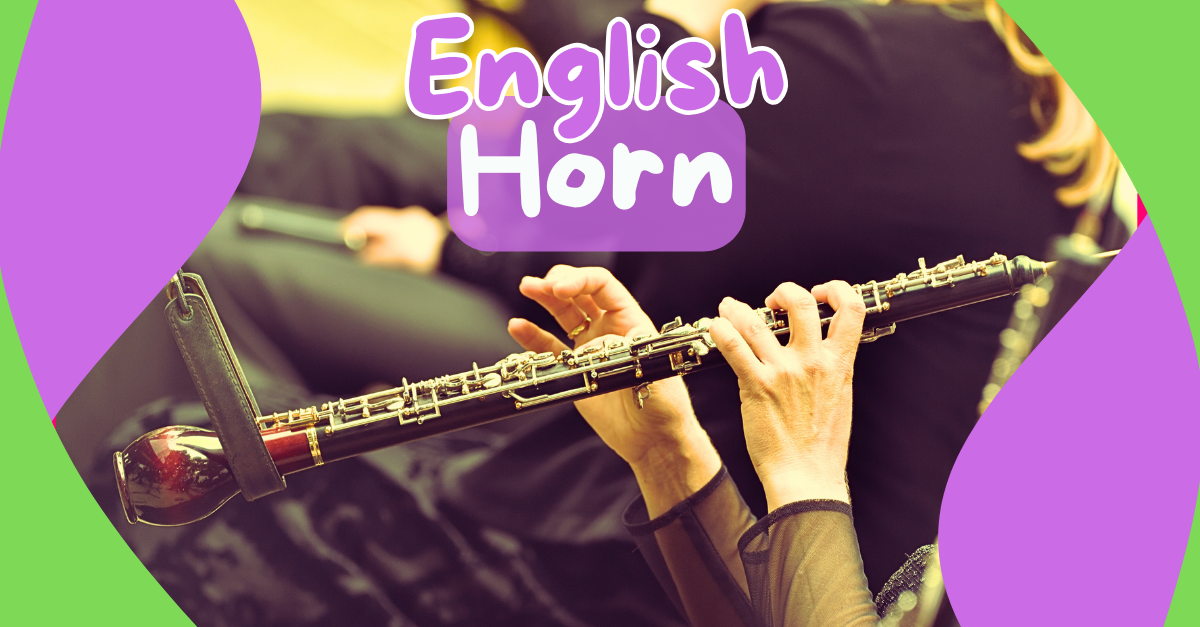The English horn is one of the most unique and captivating instruments in the orchestra, often overlooked but essential to the overall sound of a performance. Its rich, melancholic tone adds depth and emotion to a variety of musical works, making it an important instrument for both composers and musicians alike. In this article, we’ll explore 5 fascinating facts about the English horn, its history, and its role in modern music. Whether you’re a musician or simply a fan of orchestral music, the English horn is an instrument worth knowing about.
What Is the English Horn?
The English horn, despite its name, is neither English nor a horn. This instrument is a double-reed woodwind belonging to the oboe family, and it is pitched in F. It has a larger and deeper sound than the oboe, producing a distinctive, haunting tone that sets it apart from other woodwinds. Its design is elongated and curved, with a pear-shaped bell at the end that gives it its characteristic sound.
Sound and Role in the Orchestra
This instrument is often used to evoke a melancholic or pastoral mood, making it perfect for emotional and introspective passages in music. It is typically used in orchestral music, chamber music, and film scores. Composers often write solos for this instrument to highlight its deep, expressive qualities, adding warmth and richness to an orchestra’s woodwind section..
English Horn vs. Oboe: What’s the Difference?
Many people confuse this instrument with the oboe due to their similar appearance and both being double-reed instruments. However, there are some key differences between the two.
Size and Pitch
The most noticeable difference between the English horn and the oboe is size.This instrument is larger, which contributes to its lower pitch. While the oboe is pitched in C, the English horn is pitched in F, making it sound a fifth lower than the oboe. This lower pitch gives the English horn its darker, more resonant sound compared to the oboe’s brighter tone.
Shape
Another difference is the shape of the two instruments. This instrument has a curved metal bocal (the small, curved tube that connects the reed to the main body of the instrument) and a bulb-shaped bell, while the oboe has a straight shape with a smaller bell. These structural differences contribute to the distinct sound of each instrument.
Role in Music
The oboe often carries melodies in the orchestra due to its clear, penetrating sound. In contrast, this instrument is frequently used for sustained, expressive passages that require a richer, more introspective tone. Both instruments are essential to orchestral music, but they serve different roles within the woodwind section.
The History of the English Horn: From Baroque to Modern Times
This instrument has a long and evolving history that spans several centuries. Although its exact origins are somewhat unclear, the instrument’s development can be traced back to the Baroque period, when the first double-reed instruments started to appear in orchestras.
Early Origins
The English horn likely evolved from the tenor oboe, a larger version of the oboe that was used in Baroque music. This early form of the instrument was called the cor anglais, which translates to “English horn” in French. The term “English” may have been a misinterpretation of the word “angled,” referring to the instrument’s bent shape. By the late 18th century, it had taken on its current form and started to be used more frequently in orchestral works
Richard Wagner began to feature this woodwind instrument in their works, showcasing its ability to convey deep emotion and rich tones. Its haunting, melancholic quality made it a favorite for long, lyrical solos, often used to evoke mystery, sadness, or nostalgia. One of the most famous examples is the solo from Dvořák’s “New World Symphony,” where it plays a key melodic role in the Largo movement.
Modern Times
Today, the English horn continues to play a significant role in contemporary classical music, as well as film scores and even some experimental genres. Composers like John Williams have utilized the instrument in movie soundtracks to add depth and emotion to key scenes. Modern orchestras almost always include this woodwind instrument in their sections, and its role has expanded as more musicians and composers recognize its unique sound and contributions.
Famous English Horn Players and Compositions
This instrument has been featured in some of the most important works in classical music, and there have been many talented musicians who have brought its voice to life.
Notable English Horn Players
- Louis Bleuzet: A French oboist and English horn player, Bleuzet was known for his smooth tone and expressive playing. His performances helped elevate the profile of this woodwind instrument in the early 20th century..
- Thomas Stacy: Often regarded as one of the best players of the modern era, Stacy performed with the New York Philharmonic for over four decades and recorded many of the most famous solos for this woodwind instrument in the orchestral repertoire.
- Dominik Wollenweber: As the English horn player for the Berlin Philharmonic, Wollenweber has earned acclaim for his rich sound and masterful interpretation of classical and contemporary works.
Famous Compositions Featuring the English Horn
This instrument has been a star in numerous compositions throughout music history. Some of the most famous pieces include:
- Antonín Dvořák’s “New World Symphony”: The Largo movement features one of the most iconic English horn solos in classical music.
- Hector Berlioz’s “Harold in Italy”: This symphony features an important role for the English horn, providing a rich, emotional backdrop to the viola solo.
- Richard Wagner’s “Tristan und Isolde”: Wagner uses the English horn to create moments of profound emotional depth, particularly in the famous love theme.
How to Play the English Horn: A Beginner’s Guide
If you’re interested in learning to play this instrument, you’ll need to start with some basic techniques and knowledge that differentiate it from other woodwind instruments like the oboe. Here’s a beginner’s guide to get you started.
1. Embouchure
The embouchure, or the way your lips interact with the reed, is crucial to producing a good sound on the English horn.Since this instrument is larger and requires a slightly different embouchure than the oboe, players must use a looser, more relaxed lip formation to allow the reed to vibrate fully.
2. Fingerings
The fingerings on the instrument are very similar to the oboe, but due to its size and lower pitch, you’ll need to make slight adjustments in your finger placement to accommodate the longer keys. Practice scales and simple melodies to get accustomed to the feel of the instrument.
3. Reed Selection
Reeds are essential for producing the best sound on the instrument. Many professional players make their own reeds, but beginners can start by purchasing high-quality reeds from music stores or online retailers. Make sure to keep your reed moist and in good condition, as dry or damaged reeds can negatively impact your sound.
English Horn Care: Reeds, Maintenance, and Performance Tips
Proper care of your English horn is essential to ensure its longevity and maintain the quality of its sound. Here are some key tips for maintaining your instrument and keeping it performance-ready.
1. Reed Care
Reeds are fragile and require careful attention. Always keep your reeds in a protective case and ensure they stay properly hydrated before playing. Avoid using cracked or damaged reeds, as they will affect the tone and response of the instrument.
2. Regular Cleaning
It’s important to clean your English horn after each use to prevent moisture buildup and damage to the wood. Use a swab to remove moisture from the bore, and regularly wipe down the keys and body to keep them clean and free of debris.
3. Instrument Maintenance
Schedule regular checkups with a professional repair technician to keep your English horn in top condition. This includes making sure the pads are sealing properly, the keys are aligned, and there are no cracks or structural issues with the wood.
4. Performance Tips
To maintain a high level of performance, regularly practice long tones to improve your tone quality and endurance. Additionally, work on your articulation by practicing scales and passages that involve fast tonguing and finger coordination.
Choosing the Best English Horn: Top Brands and Models
Whether you’re a beginner or a professional, selecting the right English horn can make a big difference in your playing experience. Here are some of the top brands and models that are highly recommended by players around the world.
1. Loreé
Known for their exceptional craftsmanship, Loreé English horns are considered some of the best in the world. They offer a rich, warm tone and are often the go-to choice for professional players.
2. Fox
Fox is another top brand, offering high-quality English horns that are favored by both students and professionals. Their instruments are known for their excellent intonation and reliability.
3. Howarth
Howarth English horns are handcrafted with precision and offer a beautiful, responsive tone. Their instruments are particularly known for their even scale and clear sound.
4. Yamaha
For beginners or those looking for a more affordable option, Yamaha English horns provide excellent quality at a reasonable price. Yamaha is known for producing reliable instruments with consistent performance.
Visit My Read Magazine for a world of informative and engaging blog posts on a variety of topics!
Conclusion: The Unique Voice of the English Horn
The English horn is a truly unique instrument that brings warmth, depth, and emotion to orchestral music.Whether you’re listening to its haunting solos in famous compositions or playing the instrument yourself, it offers a rich musical experience. From its historical evolution to its role in modern orchestras, this instrument continues to be important and expressive.With proper care, attention to technique, and the right instrument, you can master the art of the English horn and contribute to its legacy in the world of music.
FAQs
- What is an English horn?
This double-reed woodwind instrument in the oboe family is known for its deep, rich tone and curved shape. - How is the English horn different from the oboe?
This Instrument Larger and pitched in F, it has a lower, more resonant sound compared to the oboe, which is pitched in C. - Who are some famous English horn players?
Notable players include Thomas Stacy, Louis Bleuzet, and Dominik Wollenweber. - What is the most famous English horn solo?
One of the most famous solos is in the Largo movement of Dvořák’s “New World Symphony”. - How do I care for my English horn reeds?
Keep your reeds in a protective case, maintain proper hydration, and replace them when they are cracked or damaged. - Which brands make the best English horns?
Top brands include Loreé, Fox, Howarth, and Yamaha. - Is the English horn hard to play?
Like any instrument, it takes practice to master, but those familiar with the oboe will find the transition smoother to this closely related woodwind. - How often should I clean my English horn?
It’s important to clean your instrument after every practice session to maintain its sound quality and longevity. - Can beginners play the English horn?
Yes, but it is recommended to have some prior experience with woodwind instruments like the oboe. - Why is it called the English horn if it’s not English or a horn?
The name likely stems from a mistranslation of the French term “cor anglais”, which could mean “angled horn” due to its bent shape.




